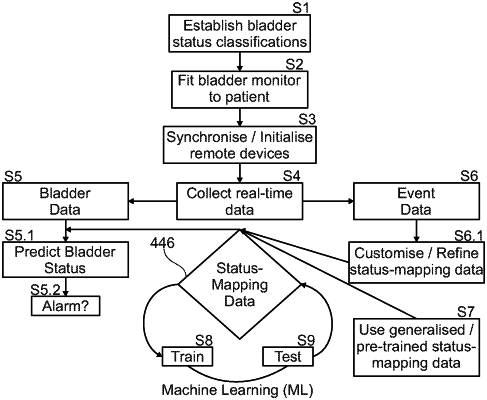| CPC G16H 40/67 (2018.01) [A61B 5/002 (2013.01); A61B 5/202 (2013.01); A61B 5/204 (2013.01); A61B 5/7267 (2013.01); A61B 5/7275 (2013.01); A61B 8/14 (2013.01); A61B 8/4227 (2013.01); G08B 21/18 (2013.01); G16H 40/63 (2018.01); G16H 50/20 (2018.01); G16H 50/30 (2018.01); A61B 5/0002 (2013.01); A61B 5/6874 (2013.01)] | 30 Claims |

|
2. A pre-void alert system, wherein the pre-void alert system is a computer system comprising:
a data-processor;
a bladder monitor operable to acquire real-time bladder data from a bladder of a subject;
a bladder-related event data collection facility configured to manually or automatically collect bladder-related event data for the data-processor; and
data storage for storing time-stamped real-time bladder data, time-stamped bladder-related event data, and status-mapping data;
wherein the data-processor is in wired or wireless communication with the bladder monitor, the bladder-related event data collection facility, and the data storage;
wherein:
the data-processor is operable:
i) to receive status-mapping data from the data storage;
ii) to receive real-time bladder data from the bladder monitor;
iii) to generate a real-time bladder status, through operating upon the real-time bladder data or part(s) thereof with the status-mapping data;
iv) to determine whether the bladder status satisfies one or more predetermined pre-void trigger criteria, and:
a. if so, triggering a pre-void alert event producing a unique output signal to enable action to be taken prior to voiding; or
b. if not, repeating steps (ii) to (iv);
wherein:
the computer system is further operable to refine the status-mapping data;
the status-mapping data comprises generic status-mapping data tailored to a particular person's attributes;
wherein the computer system is configured to manually or automatically collect data on the timing of voiding events;
wherein, on the basis the collected data on the timing of voiding events, the computer system is configured to gradually adjust the timing of the pre-void alert towards a time which better correlates with a likely urge to void;
wherein the data-processor generates the real-time bladder status by correlation of the real-time bladder data with a bladder status through operating upon the bladder data or part thereof with the status-mapping data which, after refining the status-mapping data via machine learning, includes operating upon the bladder data with one or more classifier(s) trained during the machine learning such that, where one classifier is used, said classifier predicts the bladder status directly from the bladder data fed thereto, and, where two or more classifiers are involved, each classifier produces a distinct bladder status opinion, and the opinions are aggregated to generate the bladder status.
|